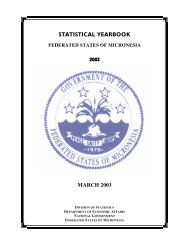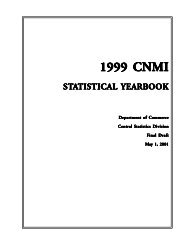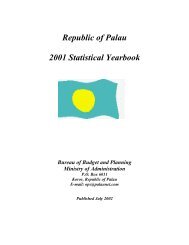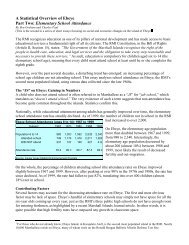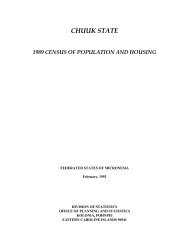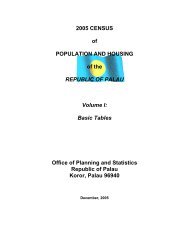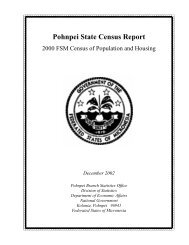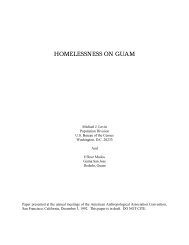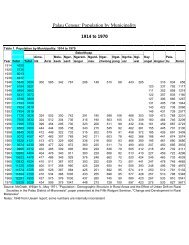Chapter 1. Introduction2000 FSM <strong>Census</strong> of <strong>Chuuk</strong> <strong>State</strong>Table 1.4. Population of <strong>Chuuk</strong> by Region: 1930 to 2000<strong>Census</strong> yearsRegion 1930 1935 1958 1967 1973 1980 1989 1994 2000Total 15,200 15,129 20,124 25,107 31,596 37,488 47,871 53,319 53,595Northern Namoneas 2,613 2,413 4,367 5,913 9,568 10,351 15,622 17,093 14,722Southern Namoneas 3911 4,379 4,785 6,062 7,401 9,146 11,455 11,898 11,694Faichuk 3,638 3,388 4,932 6,166 7,277 8,831 11,264 12,671 14,049Mortlocks 3,400 3,401 4,224 4,547 4,685 5,941 5,904 6,471 6,911Oksoritod 1,638 1,548 1,816 2,419 2,665 3,219 3,626 5,186 6,219Source: L.J. Gorenflo, 1995, 1994 and 2000 FSM <strong>Census</strong>es.Southern Namoneas increased by 167 percent between 1935 and 2000, Faichuk by 315 percent, and NorthernNamoneas by 510 percent, far more than would be expected by natural increase alone!Since 1930, the percentage of the population living on Weno has generally increased over time (with the exception ofthe 1980 census)(Table 1.5). About 3 in every 20 persons of <strong>Chuuk</strong>'s population lived in Northern Namoneas in 1935,but the proportion increased to around 6 in 20 by 1973 to 1994. The percentage on Faichuk remained essentiallyconstant over the period. The percentages for the other areas, however, decreased. Southern Namoneas decreasedfrom 29 percent to 22 percent, the percentage in the Mortlocks was almost halved -- from 21 percent to 13 percentwhile Pattiw slightly decreased by less than 1 percentage point and Namonuito slightly increased.Table 1.5. Proportional Distribution by Municipality, <strong>Chuuk</strong> <strong>State</strong>: Selected <strong>Census</strong> YearsMunicipality 1920 1925 1930 1935 1958 1967 1973 1980 1989 1994 2000Total 14,788 14,961 15,200 15,129 20,124 25,107 31,609 37,488 47,871 53,319 53,595Percent 100.0 100.0 100.0 100.0 100.0 100.0 100.0 100.0 100.0 100.0 100.0Lagoon 66.5 65.7 66.9 67.3 70.0 72.3 76.6 75.6 80.1 78.1 75.5N. Namoneas 17.4 17.0 17.2 15.9 21.7 23.6 30.3 27.6 31.9 32.1 27.5Weno 17.4 17.0 17.2 15.9 21.7 23.6 30.3 27.6 31.9 30.2 25.8Piis-Paneu … … … … … … … … … 0.9 1.0Fono … … … … … … … … … 0.9 0.7S. Namoneas 26.3 25.4 25.7 28.9 23.8 24.1 23.3 24.4 23.9 22.3 21.8Tonoas/Etten 9.1 9.7 9.5 12.7 7.6 8.0 8.1 8.6 8.1 7.4 7.3Fefen 11.0 7.8 8.0 8.2 7.7 8.1 7.8 8.2 8.2 7.6 7.6Siis … 1.0 0.9 0.7 0.9 1.0 0.8 0.9 0.9 0.9 0.9Uman 6.2 5.7 6.4 6.4 7.1 6.5 6.0 6.4 6.0 5.7 5.3Parem … 1.0 0.9 0.9 0.5 0.5 0.6 0.6 0.7 0.7 0.7Faichuk 22.8 23.5 23.9 22.3 24.5 24.6 23.0 23.6 24.3 23.8 26.2Eot … … 0.8 0.7 0.9 0.9 0.6 0.5 0.6 0.7 0.7Udot 4.4 4.1 3.5 3.4 3.1 3.5 2.9 2.9 3.2 3.0 3.3Romanum 3.0 2.0 1.9 1.5 1.2 1.1 1.2 1.2 1.4 1.3 1.9Fanapanges … 1.1 1.2 1.1 1.3 1.2 1.1 1.1 1.7 1.1 1.3Wonei … … … … … … … … … 2.7 2.4Paata … … … … … … … … … 3.4 3.6Tol 15.4 16.1 16.5 15.6 18.0 17.9 17.2 17.9 17.4 9.0 9.6Polle … … … … … … … … … 2.5 3.5Outer Islands 33.6 34.3 33.1 32.7 30.0 27.7 23.3 24.4 19.9 21.9 24.5Mortlocks … 22.7 20.4 21.1 19.5 16.9 13.9 14.7 11.5 12.1 12.9Nama … 2.6 2.6 2.7 3.4 2.1 2.2 2.7 1.9 1.7 1.9Losap … 2.1 2.0 2.2 2.3 1.8 1.4 1.6 1.0 0.9 0.8Piis-Emwar … 1.3 1.5 1.6 0.9 0.8 0.7 0.6 0.7 0.8 0.8Namoluk … 2.3 2.1 1.9 1.2 1.2 0.8 0.9 0.6 0.8 0.8Ettal … - - - - - - - - 0.7 0.5Lekinioch … 4.2 3.3 3.1 2.4 2.2 1.6 1.8 1.6 1.5 1.7Oneop … 2.5 2.2 2.7 2.0 1.7 1.3 1.3 1.1 1.0 0.9Satowan … 2.0 1.7 1.9 2.1 2.0 2.6 2.0 1.8 1.5 1.8Kuttu . … 2.5 2.3 2.2 2.4 2.0 1.2 1.3 0.9 1.2 1.6Moch … 2.0 1.8 1.8 1.9 2.1 1.4 1.7 1.3 1.6 1.6Ta … 0.8 0.9 1.0 0.9 1.0 0.7 0.8 0.6 0.5 0.5Pattiw … 4.7 5.7 5.4 4.1 4.5 3.7 3.3 2.9 4.1 5.1Houk … 1.0 1.5 1.5 1.2 1.2 0.8 0.5 0.7 0.9 0.8Polowat … 1.9 2.4 2.2 1.4 1.6 1.4 1.2 1.0 1.3 1.9Pollap … 1.0 1.0 1.0 1.0 1.2 1.0 1.1 0.7 1.3 1.7Tamatam … 0.8 0.8 0.7 0.5 0.5 0.5 0.5 0.5 0.5 0.78 <strong>Chuuk</strong> Branch Statistics Office, Division of Statistics, FSM Department of Economic Affairs
2000 FSM <strong>Census</strong> of <strong>Chuuk</strong> <strong>State</strong>Chapter 1. IntroductionTable 1.5. Proportional Distribution by Municipality, <strong>Chuuk</strong> <strong>State</strong>: Selected <strong>Census</strong> Years (continued)Municipaltiy 1920 1925 1930 1935 1958 1967 1973 1980 1989 1994 2000Namonuito … 2.2 2.0 2.0 1.8 1.8 2.0 2.2 2.1 1.9 2.5Makur … … … … 0.2 0.2 0.2 0.3 0.3 0.3 0.3Onoun … 0.9 0.9 0.8 0.9 1.0 1.2 1.2 1.1 0.8 1.1Onou … 0.4 0.4 0.4 0.2 0.2 0.1 0.2 0.2 0.2 0.3Unanu … 0.6 0.4 0.5 0.2 0.1 0.1 0.2 0.2 0.2 0.3Piherarh … 0.3 0.3 0.3 0.3 0.3 0.4 0.3 0.3 0.3 0.5Halls … 2.8 3.1 3.0 3.1 3.3 2.7 3.2 2.7 3.8 4.0Nomwin … 0.7 0.7 0.7 1.1 1.1 0.9 0.9 0.8 1.4 1.3Fananu … 0.8 0.9 0.8 0.5 0.6 0.6 0.6 0.5 0.6 0.7Ruo … 0.6 0.7 0.7 0.7 0.7 0.6 0.8 0.8 0.7 0.9Murillo … 0.7 0.8 0.8 0.8 0.9 0.6 0.9 0.6 1.0 1.1Source: Nan'yo (1927, 1931, 1937); Office of the <strong>Census</strong> Coordinator (1975); Office of High Commissioner (1959); School of Public Health (n.d); US Bureau of the<strong>Census</strong>; (1972, 1983a); <strong>Chuuk</strong> Office of Planning and Statistics ( 1992a, 1988, 1989); 1994 FSM <strong>Census</strong>, Table P13; 2000 FSM <strong>Census</strong>, Table P2-1.Note: "…" denote no data available because the municipality was once part of a different municipality.The 1930 <strong>Census</strong> was the first to obtain distributions by age. These distributions allow for interpretation of changingpopulation dynamics over time, including calculation of a dependency ratio of number of probable dependents topotential workers. Adding the number of persons less than 15 years old to those 60 years and over, and dividing by thenumber of persons 15 to 59 years old calculate the dependency ratio for 1930, from data in Table 1.6. That is, it is mostprobable that persons under 15 years old are not contributing to the work force because they are in school or playing orworking around the house, and those 60 years and over are mostly "retired", and, while not all those 15 to 59 areworking to support these "dependents", many of them are, and for simplification, all appear in the denominator.However, the dependency ratio from 1930 -- 68 means that for every 68 dependents (the 6,150 persons less than 15 and60 years and over), about 100 potential workers (the 9050 persons 15 to 59) were present. A ratio of 100 would meanthat their numbers of dependents and potential workers were identical; a ratio over 100 would mean that there weremore dependents than workers, a situation, which would put increased burden on the workers.Table 1.6. Population of <strong>Chuuk</strong> by Age and Region: 1930.Age GroupRegion Number Total 0-14 years 15-24 years 25-59 years 60 years or moreTotal 15,200 100.0 38.5 16.7 42.9 2.0Northern Namoneas 2,613 100.0 37.2 16.6 44.9 1.4Southern Namoneas 3,911 100.0 39.0 18.6 40.7 1.7Faichuk 3,638 100.0 37.5 15.7 45.2 1.8Mortlocks 3,400 100.0 42.1 16.0 38.5 3.5Oksoritod 1,638 100.0 34.6 15.7 48.9 0.7Source: Nan'yo-cho 1931.In 1930, life expectancy in <strong>Chuuk</strong> remained low. Only two percent of the population was 60 years or older. It isimportant to remember, however, that while life at that time was rougher than now, so we might expect higher earlymortality (because of typhoons, tidal waves, canoe voyaging, appendicitis and other health risks, etc.), it is also true thatmany people did not know their birth dates and may have picked younger (or older) ages than their actual ages. About3.5 percent of the Mortlocks population was 60 years and over, indicating possible age inflation, while less than 1percent of those in Oksoritod were 60 years and over.The Mortlocks also had the largest percentage of persons less than 15 years old, indicating a slightly higher birthratethan in the other areas. On the other hand, while Oksoritod had the smallest percentage of elderly, they also had thesmallest percentage less than 15 years old.It could be argued that some of the difference in age reporting was due to migration between their home area and wherethey were enumerated. The data in Table 1.7, however, seem to show that this was not the case. It is true that 1.5percent of those living in Oksoritod were "registered" in another district -- most likely in Yap because of traditionalinter-island voyaging and associated marriages and adoptions. However, the fairly large percentage of persons living inOksoritod but being registered elsewhere in <strong>Chuuk</strong> seems anomalous unless the Japanese were moving persons around(or, perhaps, movements from the Lagoon to the Hall Islands.) The situation for the Mortlocks seems more consistentwith what would have been expected at the time, more than 19 out of 20 Mortlockese being registered and living in thesame locality -- although in the case of the Mortlockese on Pohnpei, the statistics would probably look quite different.<strong>Chuuk</strong> Branch Statistics Office, Division of Statistics, FSM Department of Economic Affairs 9
- Page 5: iii
- Page 12 and 13: Preface2000 FSM Census of Chuukx
- Page 14 and 15: Table of contents2000 FSM Census of
- Page 16 and 17: LIST OF TEXT TABLESTABLEPageChapter
- Page 18 and 19: List of Text Table2000 FSM Census o
- Page 20 and 21: LIST OF FIGURESFIGUREPageFigure 1.1
- Page 22 and 23: List of Basic-Tables2000 FSM Census
- Page 24 and 25: MAP OF FSMxxiiChuuk Branch Statisti
- Page 27 and 28: 2000 FSM Census of Chuuk StateExecu
- Page 29 and 30: CHAPTER 1INTRODUCTIONThe creation o
- Page 31 and 32: 2000 FSM Census of Chuuk StateChapt
- Page 33 and 34: 2000 FSM Census of Chuuk StateChapt
- Page 35: 2000 FSM Census of Chuuk StateChapt
- Page 39 and 40: 2000 FSM Census of Chuuk StateChapt
- Page 41 and 42: 2000 FSM Census of Chuuk StateChapt
- Page 43 and 44: 2000 FSM Census of Chuuk State Chap
- Page 45: 2000 FSM Census of Chuuk StateChapt
- Page 48 and 49: Chapter 2. Age and Sex Structure200
- Page 50 and 51: Chapter 2. Age and Sex Structure200
- Page 52 and 53: Chapter 2. Age and Sex Structure200
- Page 55 and 56: CHAPTER 3HOUSEHOLDS, FAMILIES, AND
- Page 57 and 58: 2000 FSM Census of Chuuk StateChapt
- Page 59 and 60: 2000 FSM Census of Chuuk StateChapt
- Page 61: 2000 FSM Census of Chuuk StateChapt
- Page 64 and 65: Chapter 4. Fertility2000 FSM Census
- Page 66 and 67: Chapter 4. Fertility2000 FSM Census
- Page 68 and 69: Chapter 4. Fertility2000 FSM Census
- Page 71 and 72: CHAPTER 5MORTALITYIntroductionAs re
- Page 73 and 74: 2000 FSM Census of Chuuk StateChapt
- Page 75: 2000 FSM Census of Chuuk StateChapt
- Page 78 and 79: Chapter 6. Migration2000 FSM Census
- Page 80 and 81: Chapter 6. Migration2000 FSM Census
- Page 82 and 83: Chapter 6. Migration2000 FSM Census
- Page 84 and 85: Chapter 6. Migration2000 FSM Census
- Page 86 and 87:
Chapter 7. Religion, Ethnicity, and
- Page 88 and 89:
Chapter 7. Religion, Ethnicity, and
- Page 90 and 91:
Chapter 7. Religion, Ethnicity, and
- Page 92 and 93:
Chapter 8. Education2000 FSM Census
- Page 94 and 95:
Chapter 8. Education2000 FSM Census
- Page 96 and 97:
Chapter 8. Education2000 FSM Census
- Page 98 and 99:
Chapter 8. Education2000 FSM Census
- Page 100 and 101:
Chapter 8. Education2000 FSM Census
- Page 103 and 104:
CHAPTER 9ECONOMIC ACTIVITYIntroduct
- Page 105 and 106:
2000 FSM Census of Chuuk StateChapt
- Page 107 and 108:
2000 FSM Census of Chuuk StateChapt
- Page 109 and 110:
2000 FSM Census of Chuuk StateChapt
- Page 111 and 112:
2000 FSM Census of Chuuk StateChapt
- Page 113 and 114:
2000 FSM Census of Chuuk StateChapt
- Page 115 and 116:
2000 FSM Census of Chuuk StateChapt
- Page 117 and 118:
CHAPTER 10INDUSTRY AND OCCUPATIONIn
- Page 119 and 120:
2000 FSM Census of Chuuk StateChapt
- Page 121 and 122:
2000 FSM Census of Chuuk StateChapt
- Page 123 and 124:
2000 FSM Census of Chuuk StateChapt
- Page 125 and 126:
2000 FSM Census of Chuuk StateChapt
- Page 127 and 128:
2000 FSM Census of Chuuk StateChapt
- Page 129 and 130:
CHAPTER 11INCOMEIntroductionThe 200
- Page 131 and 132:
2000 FSM Census of Chuuk StateChapt
- Page 133 and 134:
2000 FSM Census of Chuuk StateChapt
- Page 135 and 136:
2000 FSM Census of Chuuk StateChapt
- Page 137:
2000 FSM Census of Chuuk StateChapt
- Page 140 and 141:
Chapter 12. Housing2000 FSM Census
- Page 142 and 143:
Chapter 12. Housing2000 FSM Census
- Page 144 and 145:
Chapter 12. Housing2000 FSM Census
- Page 146 and 147:
Chapter 12. Housing2000 FSM Census
- Page 148 and 149:
Chapter 12. Housing2000 FSM Census
- Page 150 and 151:
Chapter 12. Housing2000 FSM Census
- Page 152 and 153:
Chapter 12. Housing2000 FSM Census
- Page 154:
Chapter 12. Housing2000 FSM Census
- Page 157 and 158:
BIBLIOGRAPHYArriaga, E.E., (1983).
- Page 159:
2000 FSM Census of Chuuk StateBibli
- Page 162 and 163:
Basic Tables2000 FSM Census of Chuu
- Page 164 and 165:
Basic Tables2000 FSM Census of Chuu
- Page 166 and 167:
Basic Tables2000 FSM Census of Chuu
- Page 168 and 169:
Basic Tables2000 FSM Census of Chuu
- Page 170 and 171:
Basic Tables2000 FSM Census of Chuu
- Page 172 and 173:
Basic Tables2000 FSM Census of Chuu
- Page 174 and 175:
Basic Tables2000 FSM Census of Chuu
- Page 176 and 177:
Basic Tables2000 FSM Census of Chuu
- Page 178 and 179:
Basic Tables2000 FSM Census of Chuu
- Page 180 and 181:
Basic Tables2000 FSM Census of Chuu
- Page 182 and 183:
Basic Tables2000 FSM Census of Chuu
- Page 184 and 185:
Basic Tables2000 FSM Census of Chuu
- Page 186 and 187:
Basic Tables2000 FSM Census of Chuu
- Page 188 and 189:
Basic Tables2000 FSM Census of Chuu
- Page 190 and 191:
Basic Tables2000 FSM Census of Chuu
- Page 192 and 193:
Basic Tables2000 FSM Census of Chuu
- Page 194 and 195:
Basic Tables2000 FSM Census of Chuu
- Page 196 and 197:
Basic Tables2000 FSM Census of Chuu
- Page 198 and 199:
Basic Tables2000 FSM Census of Chuu
- Page 200 and 201:
Basic Tables2000 FSM Census of Chuu
- Page 202 and 203:
Basic Tables2000 FSM Census of Chuu
- Page 204 and 205:
Basic Tables2000 FSM Census of Chuu
- Page 206 and 207:
Basic Tables2000 FSM Census of Chuu
- Page 208 and 209:
Basic Tables2000 FSM Census of Chuu
- Page 210 and 211:
Basic Tables2000 FSM Census of Chuu
- Page 212 and 213:
Basic Tables2000 FSM Census of Chuu
- Page 214 and 215:
Basic Tables2000 FSM Census of Chuu
- Page 216 and 217:
Basic Tables2000 FSM Census of Chuu
- Page 218 and 219:
Basic Tables2000 FSM Census of Chuu
- Page 220 and 221:
Basic Tables2000 FSM Census of Chuu
- Page 222 and 223:
Basic Tables2000 FSM Census of Chuu
- Page 224 and 225:
Basic Tables2000 FSM Census of Chuu
- Page 226 and 227:
Basic Tables2000 FSM Census of Chuu
- Page 228 and 229:
Basic Tables2000 FSM Census of Chuu
- Page 230 and 231:
Basic Tables2000 FSM Census of Chuu
- Page 232 and 233:
Basic Tables2000 FSM Census of Chuu
- Page 234 and 235:
Basic Tables2000 FSM Census of Chuu
- Page 236 and 237:
Basic Tables2000 FSM Census of Chuu
- Page 238 and 239:
Basic Tables2000 FSM Census of Chuu
- Page 240 and 241:
Basic Tables2000 FSM Census of Chuu
- Page 242 and 243:
Basic Tables2000 FSM Census of Chuu
- Page 244 and 245:
Basic Tables2000 FSM Census of Chuu
- Page 246 and 247:
Basic Tables2000 FSM Census of Chuu
- Page 248 and 249:
Basic Tables2000 FSM Census of Chuu
- Page 250 and 251:
Basic Tables2000 FSM Census of Chuu
- Page 252 and 253:
Basic Tables2000 FSM Census of Chuu
- Page 254 and 255:
Basic Tables2000 FSM Census of Chuu
- Page 256 and 257:
Basic Tables2000 FSM Census of Chuu
- Page 258 and 259:
Basic Tables2000 FSM Census of Chuu
- Page 260 and 261:
Basic Tables2000 FSM Census of Chuu
- Page 262 and 263:
Basic Tables2000 FSM Census of Chuu
- Page 264 and 265:
Basic Tables2000 FSM Census of Chuu
- Page 266 and 267:
Basic Tables2000 FSM Census of Chuu
- Page 268 and 269:
Basic Tables2000 FSM Census of Chuu
- Page 270 and 271:
Basic Tables2000 FSM Census of Chuu
- Page 272 and 273:
Basic Tables2000 FSM Census of Chuu
- Page 274 and 275:
Basic Tables2000 FSM Census of Chuu
- Page 276 and 277:
Basic Tables2000 FSM Census of Chuu
- Page 278 and 279:
Basic Tables2000 FSM Census of Chuu
- Page 280 and 281:
Basic Tables2000 FSM Census of Chuu
- Page 282 and 283:
Basic Tables2000 FSM Census of Chuu
- Page 284 and 285:
Basic Tables2000 FSM Census of Chuu
- Page 286 and 287:
Basic Tables2000 FSM Census of Chuu
- Page 288 and 289:
Basic Tables2000 FSM Census of Chuu
- Page 290 and 291:
Basic Tables2000 FSM Census of Chuu
- Page 292 and 293:
Questionnaire2000 FSM Census of Chu
- Page 294 and 295:
Questionnaire2000 FSM Census of Chu
- Page 296 and 297:
Questionnaire2000 FSM Census of Chu



